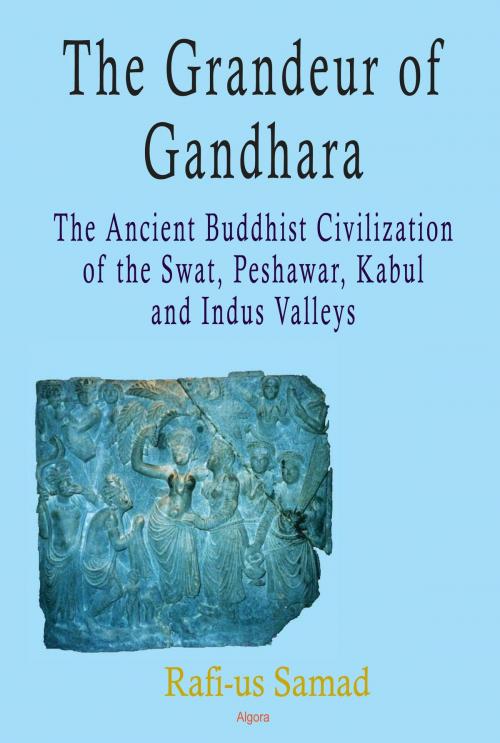The Grandeur of Gandhara: The Ancient Buddhist Civilization of the Swat, Peshawar, Kabul and Indus Valleys
Nonfiction, History, Asian, India| Author: | Rafi-us Samad | ISBN: | 9780875868608 |
| Publisher: | Algora Publishing | Publication: | December 15, 2009 |
| Imprint: | Algora Publishing | Language: | English |
| Author: | Rafi-us Samad |
| ISBN: | 9780875868608 |
| Publisher: | Algora Publishing |
| Publication: | December 15, 2009 |
| Imprint: | Algora Publishing |
| Language: | English |
Detailed archaeological excavations were started at sites in northern Pakistan and Afghanistan in the late-19th century. Through these excavations, eminent archaeologists such as Aurel Stein, Alexander Cunningham, John Marshall, J. Barthoux and Professor A.H. Dani recovered hundreds of thousands of beautiful stone sculptures belonging to the Gandhara Civilization.
In the last century or so, much has been written about the artistic quality of these beautiful stone sculptures. But hardly anything has been written about the Civilization itself that gave birth to these extraordinary pieces of art. In this book an effort has been made to present Gandhara in its wider perspective, highlighting the different features of a unique civilization in which many different races contributed and many cultures merged to bring about a major sociological change and establish a distinct cultural identity in this region of the South Asian sub-continent.
This book is based on the author's analysis of the reports of renowned archaeologists who carried out excavations at various sites, information gathered during the past decade through extended visits to numerous archaeological sites associated with the lost Gandhara Civilization including those in the Taxila, Peshawar, Charsadda, Mardan and Swat regions in Pakistan, and study of the large number of artifacts from these sites which are on display in museums.
His research reveals a great deal of continuity in the field of socio-cultural development of the region, which is referred to in this book as Greater Gandhara, from the time it became a part of the Achaemenid Empire in the 6th century BCE till the end of Kidara Kushans rule in the 5th century CE. Further, it reveals that after the Achaemenids had established the physical and administrative infrastructure in Greater Gandhara, the continuity in socio-cultural development in the region was maintained mainly by the growing Buddhist population.
This book illustrates the spirit of independence and features in the character of the ancient people of the Gandhara region which facilitated the sustained progress towards the emergence of the Gandhara Civilization. Following the invasion of Alexander the Great, his successors had no difficulty in colonizing Bactria (Northern Afghanistan) and Sogdia (Uzbekistan), but they could not do the same in Gandhara. Similarly the Scythians, Parthians and the Kushans ruled over the Central Asian region as colonizers, but not so in Gandhara. Here they ruled not over the people, but with the people. Their administration was highly de-centralized, with the locals playing a major role in the regional administration and having a major say in the social and cultural affairs of the entire population.
Finally, the book highlights the interactive environment which prevailed in Gandhara throughout the transient and mature phases of the Gandhara Civilization: Alexanders companions hobnobbing with the naked fakirs of Taxila; Menander, the great Indus-Greek ruler, finding time to engage in prolonged question-and-answer sessions with Buddhist scholars at the monastery near Sagala (Sialkot); and the greatest of the Kushan conquerors, Kanishka, finding pleasure in the company of local intellectuals and artists such as Asvaghosha and Vasumitra, and presiding over the official launch of Mahayana Buddhism.
In the last century or so, much has been written about the artistic quality of these beautiful stone sculptures. But hardly anything has been written about the Civilization itself that gave birth to these extraordinary pieces of art. In this book an effort has been made to present Gandhara in its wider perspective, highlighting the different features of a unique civilization in which many different races contributed and many cultures merged to bring about a major sociological change and establish a distinct cultural identity in this region of the South Asian sub-continent.
This book is based on the author's analysis of the reports of renowned archaeologists who carried out excavations at various sites, information gathered during the past decade through extended visits to numerous archaeological sites associated with the lost Gandhara Civilization including those in the Taxila, Peshawar, Charsadda, Mardan and Swat regions in Pakistan, and study of the large number of artifacts from these sites which are on display in museums.
His research reveals a great deal of continuity in the field of socio-cultural development of the region, which is referred to in this book as Greater Gandhara, from the time it became a part of the Achaemenid Empire in the 6th century BCE till the end of Kidara Kushans rule in the 5th century CE. Further, it reveals that after the Achaemenids had established the physical and administrative infrastructure in Greater Gandhara, the continuity in socio-cultural development in the region was maintained mainly by the growing Buddhist population.
This book illustrates the spirit of independence and features in the character of the ancient people of the Gandhara region which facilitated the sustained progress towards the emergence of the Gandhara Civilization. Following the invasion of Alexander the Great, his successors had no difficulty in colonizing Bactria (Northern Afghanistan) and Sogdia (Uzbekistan), but they could not do the same in Gandhara. Similarly the Scythians, Parthians and the Kushans ruled over the Central Asian region as colonizers, but not so in Gandhara. Here they ruled not over the people, but with the people. Their administration was highly de-centralized, with the locals playing a major role in the regional administration and having a major say in the social and cultural affairs of the entire population.
Finally, the book highlights the interactive environment which prevailed in Gandhara throughout the transient and mature phases of the Gandhara Civilization: Alexanders companions hobnobbing with the naked fakirs of Taxila; Menander, the great Indus-Greek ruler, finding time to engage in prolonged question-and-answer sessions with Buddhist scholars at the monastery near Sagala (Sialkot); and the greatest of the Kushan conquerors, Kanishka, finding pleasure in the company of local intellectuals and artists such as Asvaghosha and Vasumitra, and presiding over the official launch of Mahayana Buddhism.
Detailed archaeological excavations were started at sites in northern Pakistan and Afghanistan in the late-19th century. Through these excavations, eminent archaeologists such as Aurel Stein, Alexander Cunningham, John Marshall, J. Barthoux and Professor A.H. Dani recovered hundreds of thousands of beautiful stone sculptures belonging to the Gandhara Civilization.
In the last century or so, much has been written about the artistic quality of these beautiful stone sculptures. But hardly anything has been written about the Civilization itself that gave birth to these extraordinary pieces of art. In this book an effort has been made to present Gandhara in its wider perspective, highlighting the different features of a unique civilization in which many different races contributed and many cultures merged to bring about a major sociological change and establish a distinct cultural identity in this region of the South Asian sub-continent.
This book is based on the author's analysis of the reports of renowned archaeologists who carried out excavations at various sites, information gathered during the past decade through extended visits to numerous archaeological sites associated with the lost Gandhara Civilization including those in the Taxila, Peshawar, Charsadda, Mardan and Swat regions in Pakistan, and study of the large number of artifacts from these sites which are on display in museums.
His research reveals a great deal of continuity in the field of socio-cultural development of the region, which is referred to in this book as Greater Gandhara, from the time it became a part of the Achaemenid Empire in the 6th century BCE till the end of Kidara Kushans rule in the 5th century CE. Further, it reveals that after the Achaemenids had established the physical and administrative infrastructure in Greater Gandhara, the continuity in socio-cultural development in the region was maintained mainly by the growing Buddhist population.
This book illustrates the spirit of independence and features in the character of the ancient people of the Gandhara region which facilitated the sustained progress towards the emergence of the Gandhara Civilization. Following the invasion of Alexander the Great, his successors had no difficulty in colonizing Bactria (Northern Afghanistan) and Sogdia (Uzbekistan), but they could not do the same in Gandhara. Similarly the Scythians, Parthians and the Kushans ruled over the Central Asian region as colonizers, but not so in Gandhara. Here they ruled not over the people, but with the people. Their administration was highly de-centralized, with the locals playing a major role in the regional administration and having a major say in the social and cultural affairs of the entire population.
Finally, the book highlights the interactive environment which prevailed in Gandhara throughout the transient and mature phases of the Gandhara Civilization: Alexanders companions hobnobbing with the naked fakirs of Taxila; Menander, the great Indus-Greek ruler, finding time to engage in prolonged question-and-answer sessions with Buddhist scholars at the monastery near Sagala (Sialkot); and the greatest of the Kushan conquerors, Kanishka, finding pleasure in the company of local intellectuals and artists such as Asvaghosha and Vasumitra, and presiding over the official launch of Mahayana Buddhism.
In the last century or so, much has been written about the artistic quality of these beautiful stone sculptures. But hardly anything has been written about the Civilization itself that gave birth to these extraordinary pieces of art. In this book an effort has been made to present Gandhara in its wider perspective, highlighting the different features of a unique civilization in which many different races contributed and many cultures merged to bring about a major sociological change and establish a distinct cultural identity in this region of the South Asian sub-continent.
This book is based on the author's analysis of the reports of renowned archaeologists who carried out excavations at various sites, information gathered during the past decade through extended visits to numerous archaeological sites associated with the lost Gandhara Civilization including those in the Taxila, Peshawar, Charsadda, Mardan and Swat regions in Pakistan, and study of the large number of artifacts from these sites which are on display in museums.
His research reveals a great deal of continuity in the field of socio-cultural development of the region, which is referred to in this book as Greater Gandhara, from the time it became a part of the Achaemenid Empire in the 6th century BCE till the end of Kidara Kushans rule in the 5th century CE. Further, it reveals that after the Achaemenids had established the physical and administrative infrastructure in Greater Gandhara, the continuity in socio-cultural development in the region was maintained mainly by the growing Buddhist population.
This book illustrates the spirit of independence and features in the character of the ancient people of the Gandhara region which facilitated the sustained progress towards the emergence of the Gandhara Civilization. Following the invasion of Alexander the Great, his successors had no difficulty in colonizing Bactria (Northern Afghanistan) and Sogdia (Uzbekistan), but they could not do the same in Gandhara. Similarly the Scythians, Parthians and the Kushans ruled over the Central Asian region as colonizers, but not so in Gandhara. Here they ruled not over the people, but with the people. Their administration was highly de-centralized, with the locals playing a major role in the regional administration and having a major say in the social and cultural affairs of the entire population.
Finally, the book highlights the interactive environment which prevailed in Gandhara throughout the transient and mature phases of the Gandhara Civilization: Alexanders companions hobnobbing with the naked fakirs of Taxila; Menander, the great Indus-Greek ruler, finding time to engage in prolonged question-and-answer sessions with Buddhist scholars at the monastery near Sagala (Sialkot); and the greatest of the Kushan conquerors, Kanishka, finding pleasure in the company of local intellectuals and artists such as Asvaghosha and Vasumitra, and presiding over the official launch of Mahayana Buddhism.















